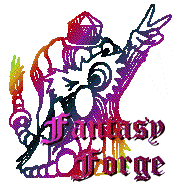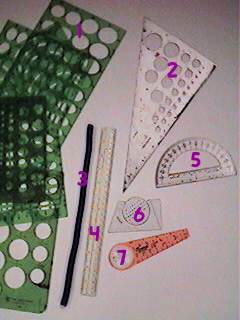 Return to the Lesson Menu |
|
 Return to the Lesson Menu |
|
 Equipment
Equipment
Shown here are some basic tools for drawing and measuring precisely rendered lines.
1) The green templates are for drawing circles and ellipses (ovals). Templates like these can be purchased from most office supply stores as well as any place that drafting supplies are available. They are seldom needed for the normal drawing of contour lines, but they can come in handy when quickly drawing lines need some smoothing out.
2) The object at the top right of the picture is a 30, 60, 90 triangle. This tool is most commonly used for detail drafting and architectural perspectives, but it can come in handy when a quick angle is needed (this model also has a circle template built in and a ruler down one side - both handy features).
3) The blue plastic toward the center is a flexible curve. Some still use a French curve, but this version is more versatile, and still allows one to recreate the same line repeatedly.
4) The clear stick at the center is a common twelve inch ruler. This one is clear, and has the advantage of allowing an artist to see through it to better aid in proper placement. This property is not necessarily important, but can sometimes come in handy. What is important is that the side is relatively smooth and the inch and fractional inch markings are clear.
5) The semicircular device on the right is a protractor. This device is used for measuring angles, and can come in very handy when trying to construct regular polygons or for creating specific angles in linear perspective.
6) The clear device with a free turning wheel is a standard lettering guide. This device is helpful when creating evenly measured parallel lines for lettering.
7) The orange object with the free turning wheel is a compass. I personally prefer this mode to the traditional caliper variety. This one does not make a hole in the drawing surface.
Of course there is a large mathematical component to artwork. It is only in relatively recent history that the boundaries between art and science have been so decidedly formalized. During the Italian renaissance, artists had to be mathematicians and scientists. Some, like Leonardo Da Vinci, were so forward thinking that they have gone down in history as epitomizing genius.
More recent public prejudices have encouraged the compartmentalization of learning into "hard" and "soft" areas of knowledge. Public funding usually follows the "sciences" and only sheds a token to teachings considered frivolous. Even what was once considered the study of life, Biology, is now considered Biological science. Why? Because people and institutions are more likely to finance something that is a science.
Look at Freud's original writings in their original language and you might see something that reads more philosophical than scientific. But, translate that same work into English and for some reason you end up with Greek. Id, ego, superego, where did these terms come from? They are certainly not English, and they did not appear in Greek in the original text. They were changed for the sake of Americanized credibility. We have been conditioned to revere the sciences and sneer at the philosophical. Greek, thought to be the language of science, lends a subject credibility.
So, what sort of math and science do you need? Today's artists can use a good dose of algebra (as much as possible), and geometry. An understanding of basic trigonometry would be good as well. Calculus and analytic geometry are probably not fully necessary, but they will not hurt. Scientifically, I suggest everyone start with the basic biological, physical and chemical sciences and go on to behavioral scientific models. When you are in the market for peddling altered perceptions, it never hurts to know how people think and perceive their world. Basically, there is no starting prerequisites, but there is never a level of learning that could be considered too much.

Try it!
Using a piece of scratch paper with a ruler, a compass or protractor and a pencil, construct an image that curves, using only straight lines. Use the example here as a model.
The concept of round is sometimes difficult to clearly define. Like straight, we just interpret what we see. The apparently circular nature of these straight lines arises from the fact that each of them is tangent to the same arc. When enough lines are tangent to the same shape, we perceive a new space.
Try and construct a complete circle. Such a circle relates to these lines in a manner that we will later explore as negative space.